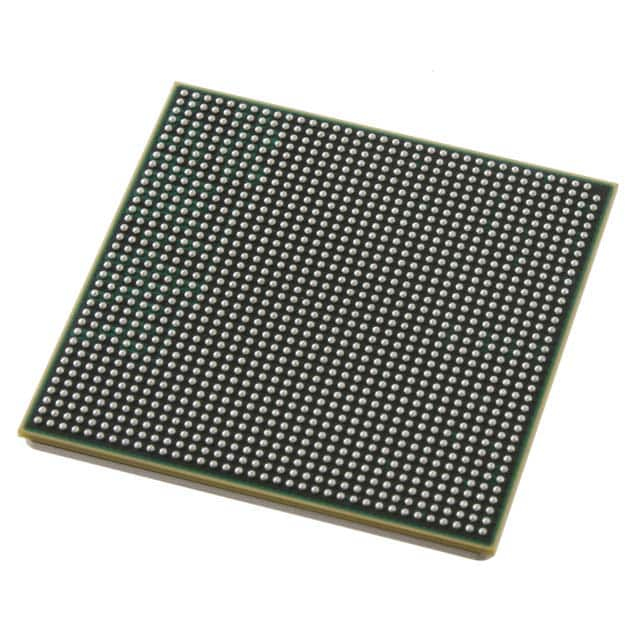Szczegóły produktu można znaleźć w specyfikacjach.

P5020NXE1QMB
Product Overview
Category
P5020NXE1QMB belongs to the category of electronic components.
Use
This product is used in various electronic devices and systems for signal processing and control purposes.
Characteristics
- High performance and reliability
- Compact size
- Low power consumption
- Wide operating temperature range
Package
P5020NXE1QMB is available in a small surface mount package, making it suitable for integration into compact electronic designs.
Essence
The essence of P5020NXE1QMB lies in its ability to process signals efficiently and accurately, contributing to the overall functionality of electronic systems.
Packaging/Quantity
This product is typically packaged in reels or trays, with each reel or tray containing a specific quantity of P5020NXE1QMB units. The exact packaging and quantity may vary depending on the supplier.
Specifications
- Operating voltage: 3.3V
- Maximum frequency: 100 MHz
- Number of pins: 64
- Input/output voltage levels: CMOS/TTL compatible
- Operating temperature range: -40°C to +85°C
Detailed Pin Configuration
- VCC
- GND
- RESET
- CLK
- DATA_IN
- DATA_OUT
- ADDR_0
- ADDR_1
- ADDR_2
- ...
(Note: The pin configuration continues up to pin 64)
Functional Features
- Signal processing capabilities
- Control logic implementation
- Data storage and retrieval
- Clock synchronization
- Address decoding
Advantages and Disadvantages
Advantages
- High performance and reliability ensure accurate signal processing.
- Compact size allows for integration into space-constrained designs.
- Low power consumption contributes to energy efficiency.
- Wide operating temperature range enables usage in various environments.
Disadvantages
- Limited maximum frequency may restrict its use in high-speed applications.
- Availability and pricing may vary depending on the supplier.
Working Principles
P5020NXE1QMB operates based on digital logic principles. It receives input signals, processes them using internal circuitry, and produces output signals according to the programmed logic. The device utilizes clock signals for synchronization and address decoding to access specific memory locations.
Detailed Application Field Plans
P5020NXE1QMB finds applications in a wide range of electronic systems, including but not limited to: - Consumer electronics - Industrial automation - Automotive electronics - Telecommunications - Medical devices
Detailed and Complete Alternative Models
- P5020NXE2QMB
- P5020NXE3QMB
- P5020NXE4QMB
- P5020NXE5QMB
- P5020NXE6QMB
(Note: The list of alternative models can be expanded based on availability and compatibility requirements.)
This concludes the encyclopedia entry for P5020NXE1QMB, providing an overview of its category, use, characteristics, package, specifications, pin configuration, functional features, advantages and disadvantages, working principles, detailed application field plans, and alternative models.
Wymień 10 typowych pytań i odpowiedzi związanych z zastosowaniem P5020NXE1QMB w rozwiązaniach technicznych
Sure! Here are 10 common questions and answers related to the application of P5020NXE1QMB in technical solutions:
1. What is P5020NXE1QMB? - P5020NXE1QMB is a specific model or version of a technical component, such as a microprocessor or integrated circuit.
2. What are the key features of P5020NXE1QMB? - The key features of P5020NXE1QMB may include high performance, low power consumption, multiple cores, advanced security features, and support for various interfaces.
3. What are the typical applications of P5020NXE1QMB? - P5020NXE1QMB can be used in a wide range of applications, including networking equipment, telecommunications systems, industrial automation, and embedded computing devices.
4. What is the power consumption of P5020NXE1QMB? - The power consumption of P5020NXE1QMB depends on various factors, such as clock speed, workload, and operating conditions. It is typically specified in the datasheet provided by the manufacturer.
5. What is the clock speed of P5020NXE1QMB? - The clock speed of P5020NXE1QMB refers to the frequency at which the processor operates. It is usually specified in megahertz (MHz) or gigahertz (GHz) in the datasheet.
6. Does P5020NXE1QMB support virtualization? - Yes, P5020NXE1QMB may support virtualization technologies, allowing multiple virtual machines to run simultaneously on the same hardware.
7. What is the maximum memory capacity supported by P5020NXE1QMB? - The maximum memory capacity supported by P5020NXE1QMB depends on the specific model and configuration. It is typically specified in the datasheet and may range from a few gigabytes to several terabytes.
8. What operating systems are compatible with P5020NXE1QMB? - P5020NXE1QMB is designed to be compatible with various operating systems, including Linux, VxWorks, and other real-time operating systems (RTOS).
9. Does P5020NXE1QMB have built-in security features? - Yes, P5020NXE1QMB may include built-in security features such as hardware encryption/decryption, secure boot, and support for secure communication protocols.
10. Can P5020NXE1QMB be used in rugged environments? - P5020NXE1QMB is often designed to withstand harsh conditions and can be used in rugged environments, making it suitable for applications in industries like aerospace, defense, and automotive.
Please note that the specific details and answers may vary depending on the actual specifications and documentation provided by the manufacturer of P5020NXE1QMB.

